Highly Recommended Award
Our Highly Recommended designation is earned by products offering extraordinary value or performance in their price class.
- Fairly accurate out-of-box color
- Over 90% DCI-P3 gamut coverage
- Vertical Lens Shift
- Supplied Android TV dongle with Netflix
- Low input lag and special game modes
- Built-in speakers
- 3D Support
- Emits quite a bit of heat
- Android TV dongle stuck in BT.2020 color space
- Somewhat low Contrast
The X3100i is an excellent gaming projector, offering gamers a compelling package for taking their gaming to the big screen with some of the lowest latency available and impressive out-of-the-box accuracy.
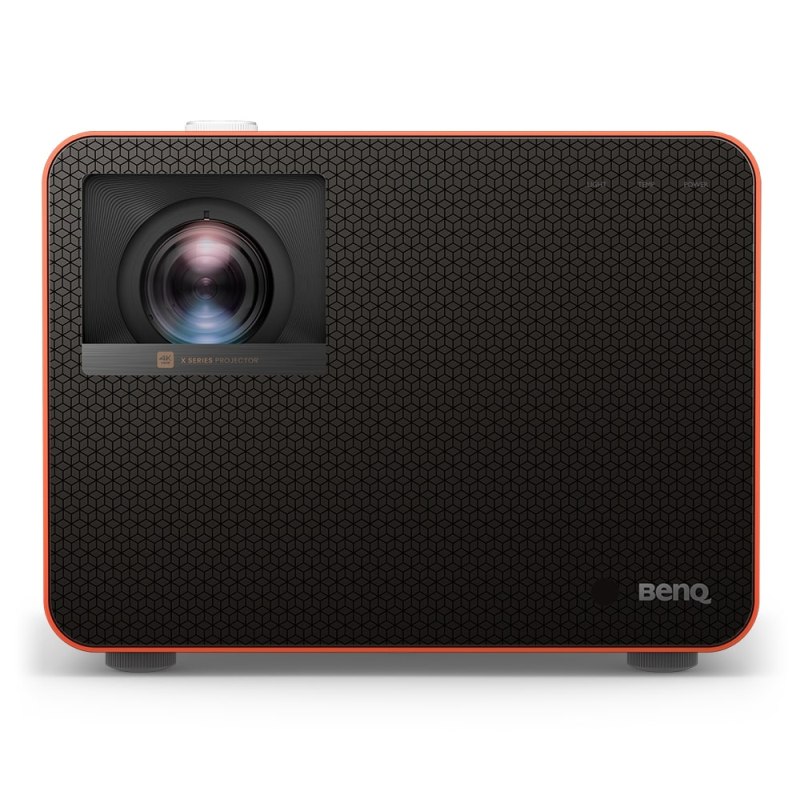
BenQ's newest entry into their Immersive Gaming series of projectors is the X3100i, a 4LED standard-throw utilizing a single-chip DLP design with a 0.65-inch DMD with a native 1080p array to which they apply four-phase pixel-shifting. Building upon their already excellent gaming performance found in other models, the X3100i now sits at the top of their gaming line and replaces the X3000i introduced and reviewed in 2022. The X3100i delivers HDR compliance with wide color gamut, 1080P/240hz gameplay, and special game modes that alter the image and sound parameters based on game type. It aims to provide the most feature rich immersive gaming experience BenQ offers.
Features
The X3100i is a 4K HDR LED gaming projector from BenQ and new for 2023, currently priced at $2,399 MSRP. Similar to its predecessor the X3000i, the X3100i utilizes a 1-chip DLP and 4LED light engine capable of providing 20,000 to 30,000 hours of light source life depending whether the unit is run in Normal, Eco or Dynamic brightness mode. It is specified for 3,300 ANSI lumens per BenQ, a 300-lumen improvement over the previous model. Additionally, the X3100i sees a boost in its rated contrast ratio compared to its predecessor, now reaching 600,000:1 for measurements that are Full On, Full Off (FOFO).
It is important to note again that the X3100i is not a native 4K projector and utilizes Texas Instrument's fastXPR pixel-shifting to put on screen all of the pixels in a 3840x2160 UHD resolution signal. It does provide a very sharp and clean image, so the fact that it is not truly native 4K shouldn't be much of an issue. Additionally, the DLP chipset did not appear to produce any rainbows in normal viewing with standard content unless I was looking for it specifically on a demanding scene, such as the white-on-black shot in Gravity when Sandra Bullock's character, wearing her space suit, is tossed away into space after the debris strike on the space shuttle.
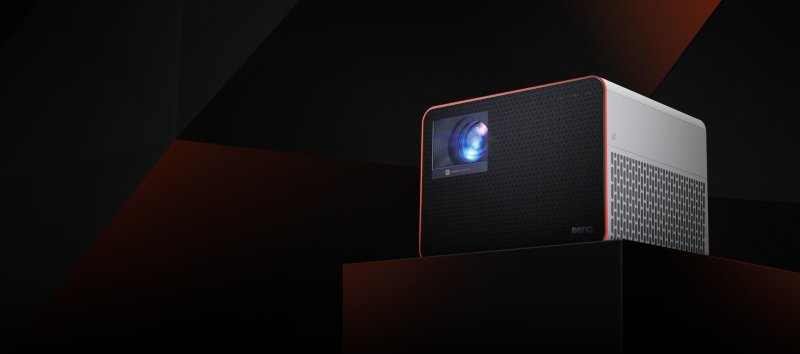
Lastly the 3,300-lumen ANSI spec for the X3100i was exceeded slightly in measurements of our sample, with the unit coming in at 3,361 lumens. However, it is important to mention that this is only achieved when the X3100i receives a full white screen at peak white 109%/video level 255, in the projector's brightest "Bright" picture mode. With this test signal only, which is specified for lumen measurements by the ANSI and ISO21118 measurement criteria, the projector will ramp up its brightness, accompanied by louder fan noise. Users will know when this happens due to this behavior, but also if the menu is called up it will have lost all color and display in monotone black, white, and gray. This level of brightness cannot be brought to bear on any real content, as introducing even one active pixel on screen or backing the signal down to something below approximately video level 240 will cause the projector to settle back to its normal brightness. This was measured at 2,949 lumens, approximately a 12.2% decrease. Technically, this is still within the 20% tolerance for ISO21118 measurements. We have gathered and listed at the end of this review both the full signal measurement and the more meaningful measurement after we allowed the unit to return to normal operating behavior.
The same optical features found on the X3000i are found here as well with one new addition. So, this means the 1.15 to 1.50:1 throw ratio is the same as before as is the 1.3x optical zoom, lens size, projection offset of 110 degrees, and key stone adjustment, as well as the capability of projecting a 60-inch diagonal to 200-inch diagonal image. What the X3100i gains, though, is a much welcome vertical lens shift allowing a shift of ±10%, or 20% of image height. This will without a doubt prove very useful for alignment of the unit to a viewer's desired screen, particularly for temporary setups. Since many projectors in this price point and category do not offer this feature it's a very welcome sight to see when it's included.
Given this presence of vertical lens shift in the X3100i and its fairly small stature—with dimensions of 10.7 x 8.4 x 10.2 inches (WxHxD) and a weight of 15 pounds—the X3100i offers a fair amount of flexibility in its installation. It allows for front or rear projection as well as table top or ceiling mounting. A 2D keystone is available if needed in a pinch, but as always it is recommended to maintain image integrity to avoid using such features, and in any event, the lowest input lag can only be achieved with keystone defeated. To help aid installation be sure to visit the ProjectorCentral BENQ X3100i projection calculator.
Per BenQ's specification, the DCI-P3 gamut coverage is the same as the previous model at 100% thanks to its DCI-P3 Cinematic Color technology and additional use of a Wide Color Gamut (WCG) filter. The filter does aid in expanding the color gamut though at the expense of light output. Our measured gamut coverage of the X3100i was close to spec; in Rec.709 it was 96.7%, and in DCI-P3, with the WCG filter active, it came in at 97.4%.
Included with the X3100i is the company's latest Android TV dongle (QS02), which is running the current Android TV 11. The dongle has a dedicated hideaway location and is installed by removing two M3 screws on the rear of the unit and sliding off the top cover to expose a cavity with an HDMI input and micro-USB cable to supply power to the dongle. This is the unit's third HDMI input. Once installed, the standard Android TV setup is commenced. It was good to see that Netflix is an authorized pre-loaded app on the included dongle.
However, similar to what we've seen with some other supplied Android dongles, it unfortunately did not properly track content type to utilize the correct color space, so even standard dynamic range content was displayed in BT.2020 color space, which resulted in heavily oversaturated color. BenQ verified this is the dongle's normal behavior where all content is output with an HDR flag and with no user setting is available to change this. However, you do have the option to switch to SDR mode by changing the device's bit depth from 10-bit to 8-bit. If you are a purist for accuracy, you will likely want to utilize either a different external streaming device that properly tracks content type, or a game console which tends to have all streaming apps available anyways. If accuracy is not a huge concern, you may be fine with using the QS02, even if the color space is incorrect. At least the supplied dongle provides two other helpful features in the ability to utilize wireless projection with AirPlay and GoogleCast.
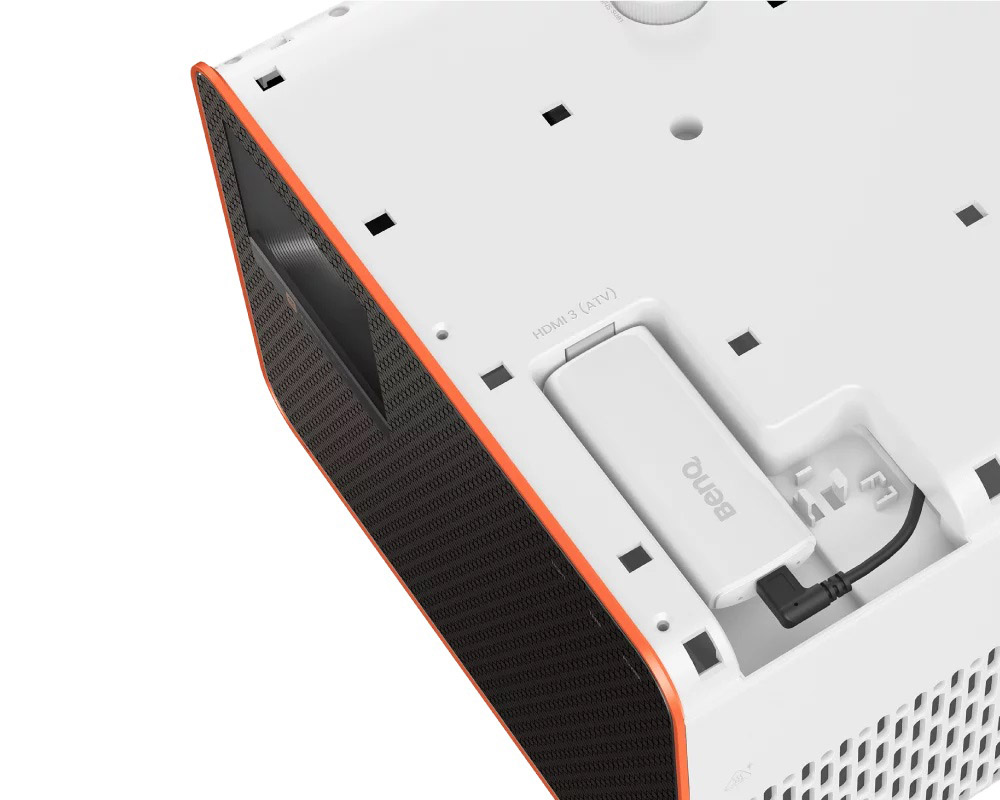
The main attraction of the X3100i is its gaming prowess, thanks to its low latency and support for up to 240Hz frame rate in 1080p resolution. Per BenQ's specification, the rated latency is 16.7ms in 1080p/60Hz and 4K/60Hz, 8.3ms at 1080p/120Hz, and 4.2ms at 1080p/240Hz. From our measurements we found this to be accurate, with the projector coming in at 17ms at 60Hz, 9ms at 120Hz and 5ms at 240Hz. This will allow gamers to experience competitive play on a large immersive screen and not sacrifice performance. Those familiar with BenQ's gaming projectors should be familiar with their Fast Mode, which lowers latency by disabling all processing. This feature is not present on the X3100i as all picture modes and inputs operate as if fast Mode was enabled; by design there is essentially no processing available on the X3100i to help it achieve such low latency. One exception is keystone correction, which isn't disabled in game play but which BenQ says will affect the latency, increasing input lag by 1 frame according to their testing. The X3100i also has approximately 16 picture modes between SDR and HDR that are labeled for specific game genres so users can have specific image and sound settings (for the internal speakers) based on the game type they're playing. Lastly the X3100i will recognize when a console is connected and allow for customized settings to be saved for up to 3 consoles. During my time with the X3100i I found it was definitely a top performer in the gaming space.
Along these lines, BenQ has also built-into the X3100i compatibility with a new gaming community feature called SettingXchange. This capability is shared with the X500i and X300G, two other new BenQ gaming projectors announced recently. It provides the ability in the future to download game-title specific color settings provided by BenQ's experts or gaming community members, via a Firmware Update tool available in the free BenQ SettingXchange PC software.
The I/O provided on the unit is pretty standard but includes eARC on one of the two HDMI 2.0 ports (on HDMI 2 specifically). This will allow object-based audio bitstreams to be sent to an external sound system such as a soundbar or AVR/AVP if RAW+ is selected as the Audio Output Format. Additional ports include a 12v trigger and RS232C for control, and USB 2.0 Type A with support for Media Reading and Firmware Upgrade. A S/PDIF is available for optical audio output, along with a 3.5mm stereo analog audio out.

For those who opt to not utilize the eARC or any of the other audio output solutions, the X3100i uses a stereo set of 5W chamber speakers which has been used on some other of BenQ's models in the past. The sound is sufficient in a pinch but for a more permanent installation a good soundbar or better yet an AVR/AVP is recommended. The sound is a slight improvement over previous models I've heard in BenQ's line, which may be due to the CinematicSound DSP that attempts to recreate a simulated 3D audio presentation. I wouldn't say it gave a sense of 3D audio, but it did sound fuller and provide a bit more clarity than other stereo 5W speaker integrations I've heard.
The remote included with the unit is fairly standard and operates via IR (infrared) and Bluetooth when controlling the Android TV dongle. It has all the buttons one would want or need, including transport buttons for FWD, REW, Play, picture menu, etc. It's also backlit. It is very responsive as well.
Performance
Color Modes. The BenQ X3100I has 15 picture modes, 7 modes for SDR and 8 for HDR. These modes are Bright, RPG (role-playing games), FPS (first-person shooter), SPG (sports games), RCG (racing games), Cinema, and User in SDR. For HDR signals, the options are HDR10, HDR10 (WCG), RPG, RPG (WCG), FPS, SPG, RCG, and User. Most of the picture modes are actually pretty good OOTB (out of the box) though can be calibrated to have a much higher degree of accuracy by fixing some inconsistencies in gamut mapping and grayscale. The only picture mode that really isn't usable is Bright due to a heavy green bias to the image. Simply selecting Normal as the color temperature mode will get viewers 95% of the way there to a correct grayscale.
OOTB User picture mode for SDR was the most accurate picture mode with the Color Temperature to Normal, and this held true for the majority of picture modes as well. With the Normal color temp, User mode tracked well for grayscale, however it pushed a slight amount of red into the image. Red and magenta were slightly over saturated and hue was off a bit in yellow and cyan.
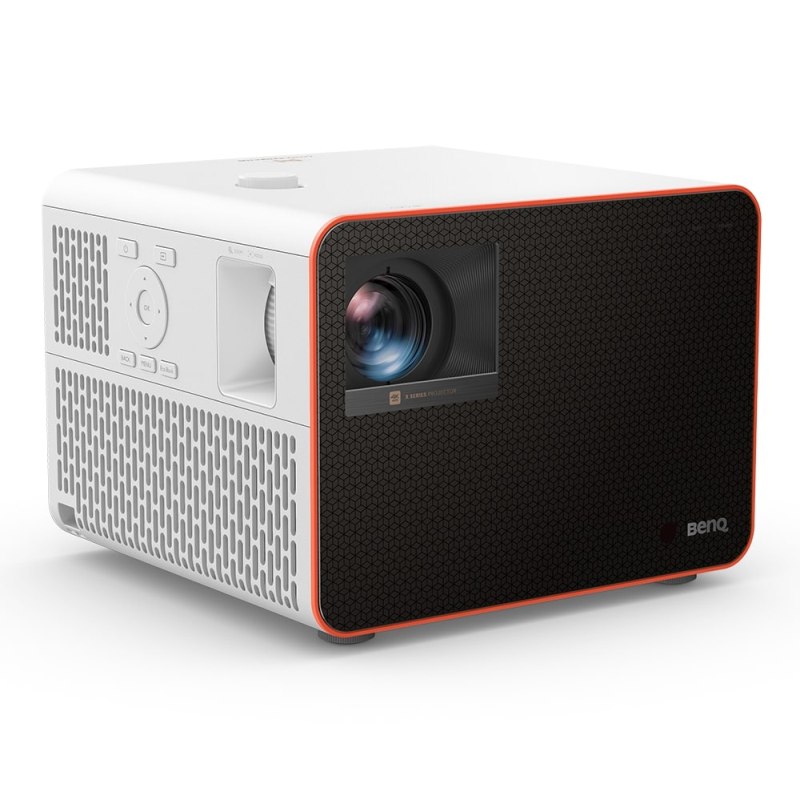
The X3100i provides the standard controls to tune color temperature/white balance using 2-point Gain and Offset, and there is a CMS (Color Management System) for adjusting the color points with Hue, Saturation, and Gain controls. The basic controls such as Brightness, Contrast, and Sharpness were also available, though Tint and Saturation were not. The X3100i's gamma settings measured correctly and were in line with their menu naming convention.
The X3100i also provides the ability to turn on its WCG (Wide Color Gamut) filter to provide more coverage of the DCI-P3 color space when an HDR signal is detected. As is the case with most BenQ projectors, the X3100i has an HDR Brightness setting that helps in resolving detail and highlights in content. This setting can be changed from -2 to +2. I found that in most cases 0 gave the best balance, though for extremely bright high APL/nit scenes the -1 setting would be viable, and for the opposite situation with low-nit/APL scenes the +1 setting is usable. I found no scenario where +/-2 worked well with content.
So, for those who choose to use the X3100i with OOTB settings and forgo calibration, the ideal picture modes to use for the most accurate image will be User with the Normal color temperature engaged. HDR10 will be the brightest of the HDR picture modes while the WCG picture modes will give better gamut coverage but at a sacrifice of about 40% light output, so a user will need to make that decision on their own.
I began calibration of the X3100i using Calman Ultimate calibration software from Portrait Displays, a Colorimetry Research CR-250 Spectroradiometer, a Colorimetry Research CR-100 Colorimeter, and a Murideo 8K Seven Generator. The X3100i was calibrated to 100-inch diagonal on a 1.3 gain Stewart Filmscreen, at approximately 8ft 11inches in distance. Prior to beginning calibration, I ran various measurements to confirm what I saw in OOTB viewing.
As mentioned, the X3100i is fairly accurate OOTB, especially in regards to the grayscale as per measurements for the Avg and Max dE errors. DeltaE is the metric used to determine visible errors. It has been determined that anything over a dE of 3 is visible, anything over 2.3 is a just noticeable difference for trained eyes and anything below 2.3 should ideally not be seen to the eye. During initial analysis, measurements and the running of various patterns including a very large Color Checker with more than 150 swatches yielded good results. In its User picture mode with Normal color temperature, the X3100i grayscale measured an average 2.5dE with a max of 5.3dE. Color Gamut had an average of 2.1dE with a Max of 4.7dE. The large Color Checker had an avg of 1.9dE with a Max of 5.6. This is very good accuracy when one factors in price to performance. Grayscale within HDR didn't fair as well and heavily under-tracked the 2084 EOTF curve.
Post calibration DeltaE errors were good though only showed a slight improvement. The calibrated User mode grayscale avg was 1.1dE with a max of 2.2dE; Color Gamut came in at 1.1dE average with a max of 1.9dE, and the Color Checker came in with 1.3dE average and 3.5dE max. HDR did ok and EOTF was raised to track a bit better, but over-tracked at the lower brightness measurements. Additionally, the CMS changes to color gamut were only minimal changes because when it gamut was corrected to be on target by measurements, the observable image was actually heavily oversaturated.
The devices used for reviewing content post-calibration were Apple TV 4K, Oppo UDP-203 Blu-ray player, Windows 11 gaming PC, PlayStation 5, and Xbox Series X.

4K/60Hz Gaming. The first game that I decided to play was Forza Motorsport. It played very well. Running on Xbox Series X at 4K/60 it felt responsive and very immersive. The image was sharp and the audio was actually decent for a quick race. I played on the Ohio Short track in the rain to get a feel for timing with turns and not once did I experience any problems or feel a lack of responsiveness with braking and cornering. I then decided to play several more races in the Track Tour series and had no problem completing the races in high standings.
The next game I decided to play was Lies of P. The reason I choose this game is because of the Perfect Guard mechanic. This is where you can hit Guard just as an attack is going to land and it will negate the damage received, as well as having the potential to break the enemies' weapons. I was easily able to do this without much effort. The first few I did miss, but after the 3rd or 4th time, I was landing them fairly consistently against the lower tier enemies (though I would image the timing to be a little tighter on boss characters). Ultimately the X3100i performed well during my brief playthrough of this game and I could easily see it being very suitable for an entire playthrough.
The last game I played was Mortal Kombat 1. I just decided to go into training mode and practice various combos with Raiden and Jax to see if I would be able to perform them as I normally would while playing on an OLED. I'm glad to say that I was easily able to transition to playing on the X3100i without too much trouble. There is a difference in latency, but it's fairly small so adjusting to the difference didn't take too long. The game looked great as well, as MK1 is a very vibrant game with a nice HDR presentation.
Need a Lamp for Your Projector?
Browse ProjectorCentral's hand-picked list of Certified Lamp Sellers to find the right lamp at the best price.
Shop Lamps
4K/HDR Viewing. Since the X3100i is primarily a gaming projector I decided to limit my viewing of movies to a minimum, though I did take some time to watch a few, one of which was Bohemian Rhapsody. Overall, the image looked good, though I quickly saw that it was over-saturated more than I would have liked, so I dialed back the color Saturation control a bit based off the HDR brightness I had selected. It didn't help as much as I wanted, so I decided to change the HDR Brightness level to 0 from the -1 setting and then reset Saturation near where I had it initially. Once this was done the skin tones looked okay overall, especially during the Live Aid concert at the end. In earlier scenes the one thing that stood out most was that yellows were slightly off-hue, such as Freddie's shirt when they began rehearsing "We Will Rock You," though I feel most would not really notice this unless they were very familiar with this movie and scene.
I next decided to watch Baby Driver. Again, this showed that red was just slightly over saturated, but much better than what I had seen in my previous viewing in Bohemian Rhapsody. This is most evident in red since it is so heavily used in various scenes in this movie. Everything else was displayed well, though. Good highlights that shine off the Red WRX used as the getaway car in the intro scene were all present, as was the detail in the clouds in the sky that can easily be lost to clipping. Overall, I enjoyed the viewing experience provided by the X3100i.

Conclusion
The BenQ X3100i is a great gaming projector, and it performs well in this regard. It performs well as a movie projector, though make no mistake about it, the X3100i is first and foremost a gaming projector since there are no picture settings for things like frame interpolation or extra processing as that would introduce latency. With a slew of picture modes aimed at various game types, Android TV with support for AirPlay and GoogleCast, a pre-loaded Netflix app, and important features such as a vertical lens shift and eARC it really does provide gamers with everything they would ideally need. Additionally, BenQ has added value to the X3100i with its SettingXchange feature and the ability, as time develops, to download settings to further optimize specific popular game titles.
Keep in mind, though, that the X3100i is basically still just the X3000i with a few added features, a slightly higher lumen specification, and a higher price tag. The X3000i, while it can still be purchased, will give roughly the same performance. As of this writing in mid-November, it's being discounted to $1,799 at major online retailers, vs. the $2,399 cost of a new X3100i. On the other hand, if you just want the newest of the new, or place high value or need on the upgraded features like vertical lens shift, a working Netflix app, slightly improved contrast, or Airplay and SettingXchange compatibility, you might lean toward the X3100i.
Ultimately a prospective buyer would need to weigh these features and determine if they're worth the increase in cost over the still available X3000i. Regardless of which model a buyer decides on, though, they will end up with a great gaming projector.
Measurements
Brightness. The BenQ X3100i is rated for 3,300 ANSI lumens. The brightest picture mode is Bright, which had a green bias which is not really suitable for viewing unless accuracy is not a concern and unit is placed in a very bright room. This picture mode measured 3,361 ANSI lumens or just under 2% higher than BenQ's published lumens specification. It is important to note, however, that the X3100i only ramps up to this brightness level while it in this picture mode and is fed a full-range white test signal at video level 255, which triggers a ramping up of fan noise and on-screen brightness. To get the usable lumen capability of the unit it requires changing the input signal to something below approximately video level 240 to get the unit to ramp down and stabilize to its actual usable lumen output with content. Under these conditions, the projector measured 2,949 ANSI lumens in Bright mode. This is a 12.2% drop in brightness, though with that measurement the X3100i is still less than 11% off its rated brightness and within the 20% tolerance for ISO21118 measurements.
Selecting Eco or Dynamic for the Light Source Mode measured a 31% light decrease vs. Normal Light Source Mode.
BenQ X3100I ANSI Lumens
| SDR Modes | Normal | Eco |
|---|---|---|
| Bright (Level 255 White) | 3,361 | N/A |
| Bright (Level 235 White) | 2,949 | 2,032 |
| RPG | 1,769 | 1,219 |
| FPS | 1,769 | 1,219 |
| SPG | 1,740 | 1,199 |
| RCG | 1,740 | 1,199 |
| Cinema | 1,740 | 1,199 |
| User | 1,740 | 1,199 |
| HDR Modes | ||
| HDR10 | 1,710 | 1,178 |
| HDR10 WCG | 1,032 | 711 |
| RPG | 1,740 | 1,199 |
| RPG WCG | 1,032 | 711 |
| FPS | 1,740 | 1,178 |
| SPG | 1,740 | 1,178 |
| RCG | 1,740 | 1,178 |
| User | 1,740 | 1,178 |
Zoom Lens Light Loss. The BenQ X3100i's light loss when shifting from the widest zoom position to its longest telephoto position was 26%.
Brightness Uniformity. The BenQ X3100i projecting a 100-inch diagonal image resulted in measured brightness uniformity of 82% while in wide angle zoom, and 82% in telephoto zoom. The brightest portion of the screen was the Middle Top sector, and the dimmest the Left Top sector. The difference in brightness on a full white and solid color screens was not noticeable on a full white screen or in actual moving content.
Fan Noise. BenQ reports the X3100i's fan noise at 32dBA in Normal Light Source Mode and 28dBA in Eco/Dynamic Mode. Using Room EQ Wizard software and a Umik-1 microphone, with my theater room ambient noise floor reading 33.3 dBA, it measured as followed. All measurements were taken at a distance of approx. 3 feet away from each side of the unit with the unit in the brightest picture mode. Measurements were the same in all SDR and HDR picture modes.
Eco/Dynamic Mode
Rear: 33.9
Left: 35.4
Top: 35.6
Right: 35.1
Normal Mode
Rear: 41.2
Left: 44.5
Top: 42.8
Right: 44.6
Input Lag. Input lag measurements were done using the FPS Picture Mode. The following supported resolutions and frame rates were tested: 4k/60 = 17ms; 1080/120 = 9ms; 1080/240 = 5ms.
Connections
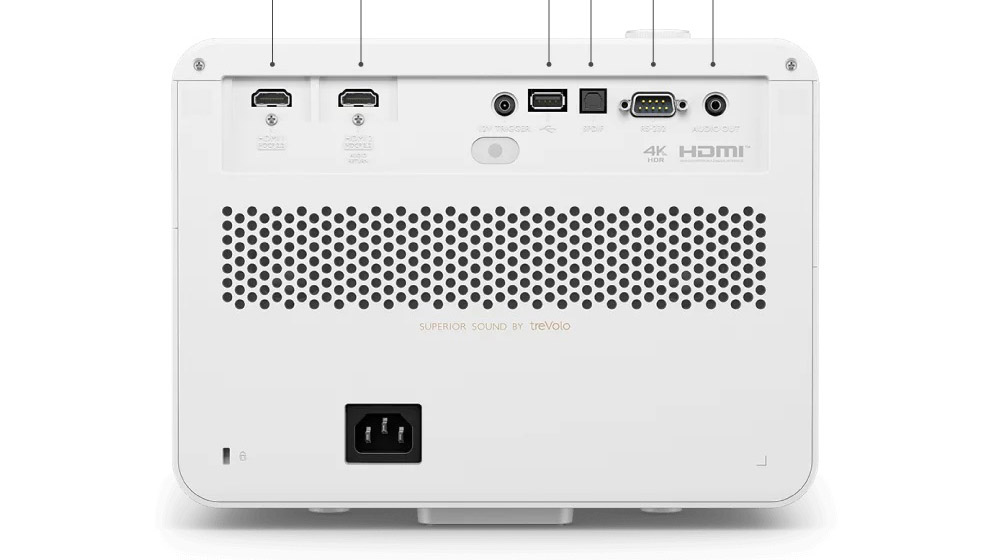
- HDMI 2.0b (x3; HDCP 2.2) (1 internal compartment, ARC on HDMI Input 2)
- USB 2.0 Type A (2.0, firmware, media reader, power delivery 1.0A)
- RS232
- 12V Trigger
- 3.5mm Audio Out
- S/PDIF
Calibrated Settings
Calibrated image settings from any third-party do not account for the significant potential for sample-to-sample variation, nor the different screen sizes and materials, lighting, lamp usage, or other environmental factors that can affect image quality. Projectors should always be calibrated in the user's own space and tuned for the expected viewing conditions. However, the settings provided here may be a helpful starting point for some. Always record your current settings before making adjustments so you can return to them as desired. Refer to the Performance section for some context for each calibration.
These settings can be used in the Game picture mode as well by simply copying settings of the desired picture mode into Game.
SDR
User
Brightness: 50
Contrast: 50
Sharpness: 3
Advanced Color Settings
Gamma: 2.4
Color Temp tuning:
R Gain: 99
G Gain: 99
B Gain: 102
Offsets = Default
Color Management
R: 238 / 194 / 230
G: 253 / 206 / 185
B: 140 / 220 / 185
C: 234 / 222 / 201
M: 260 / 161 / 202
Y: 135 / 180 / 201
Light Source Mode: ECO
HDR10 WCG
User
Brightness: 50
Contrast: 50
Sharpness: 2
Advanced Color Settings
Gamma: N/A
Color Temp tuning:
R Gain: 95
G Gain: 94
B Gain: 96
Offsets = Default
Color Management
R: 200 / 213 / 200
G: 197 / 198 / 200
B: 194 / 227 / 200
C: 200 / 217 / 200
M: 200 / 200 / 200
Y: 200 / 200 / 200
Light Source Mode: Dynamic
HDR10 User
User
Brightness: 49
Contrast: 50
Sharpness: 2
Advanced Color Settings
Gamma: N/A
Color Temp tuning:
R Gain: 98
G Gain: 100
B Gain: 101
Offsets = Default
Color Management
R: 202 / 200 / 200
G: 200 / 200 / 200
B: 205 / 208 / 200
C: 200 / 200 / 200
M: 198 / 200 / 200
Y: 200 / 205 / 200
Light Source Mode: Dynamic
HDR Brightness: -1
For more detailed specifications and connections, check out our BenQ X3100i projector page.
To buy this projector, use Where to Buy online, or get a price quote by email direct from Projector Central authorized dealers using our E-Z Quote tool.








Post a comment